List of Prime Ministers of Italy
 |
| This article is part of a series on the politics and government of Italy |
| Constitution |
|
Legislature |
|
| Foreign relations |
|
Related topics |
The Prime Minister of Italy, officially President of the Council of Ministers of Italy, is the political leader of the country since 1861. The Palazzo Chigi in Rome is the official residence of the Prime Minister. The Prime Minister is the President of the Council of Ministers (which holds effective executive power) and he must receive a vote of approval from it to execute most political activities. The office is similar to those in most other parliamentary systems, but the leader of the Italian government is not authorized to request the dissolution of the Parliament or to dismiss the ministers (that are appointed by him).
The office was established by Articles 92 through to 96 of the current Constitution of Italy. The Prime Minister is appointed by the President of the Republic after each general election. Commonly referred to in Italy as Premier, the right title of the office holder is Presidente del Consiglio dei Ministri, or just Presidente del Consiglio. The formal Italian order of precedence lists the office as being ceremonially the fourth most important Italian state office.
History
The office was first established in 1848 in Italy's predecessor state, the Kingdom of Sardinia—although it was not mentioned in the constitution, the Albertine Statute. The candidate for office was appointed by the king, and presided over a very unstable political system. In its first 60 years of existence (1861–1921), Italy changed its prime minister 37 times. Regarding this situation, the first goal of Benito Mussolini, appointed in 1922, was to abolish the Parliament's ability to put him to a vote of no confidence, thus basing his power on the will of the king and the National Fascist Party alone. With the proclamation of the Italian Republic in 1946, the office received constitutional recognition and 26 men assumed the office in 70 years.
Prime Ministers of Italy (1861–present)
Presidents of the Council of Ministers of the Kingdom of Italy (1861–1946)
- Parties
- 1861–1912: (Two-party system)
Historical Right Historical Left
- 1912–1922: (Multiparty system)
Liberal Union Radical Party Reform Socialist Party Military
- 1922–1943: (Single-party state)
- 1943–1946: (Multiparty system)
Labour Democratic Party Action Party Christian Democracy
| Portrait | Name (Birth–Death) |
Term of office | Political Party | Government | Legislature | King | ||
|---|---|---|---|---|---|---|---|---|
 |
Camillo Benso, Conte di Cavour (1810–1861) |
23 March 1861 | 6 June 1861† | Historical Right | Cavour IV | VIII (1861) | Victor Emmanuel II (1861–1878) | |
| Previously Prime Minister of Sardinia under Vittorio Emanuele II. He was a leader of the Italian unification movement, and first Prime Minister of Italy. Major challenges included the creation of a national military, the location of legal institutions, and the future of Rome, which most favoured for the capital of a united Italy. Cavour wished to incorporate the Papal States and Venetia in the new Italy, but did not live to see either.
† Died in office (stroke). His last words were reportedly L'Italia è fatta, tutto è a posto ("Italy is made. It is all right."). | ||||||||
 |
Bettino Ricasoli (1809–1880) |
6 June 1861 | 3 March 1862 | Historical Right | Ricasoli I | |||
| Previously Minister of the Interior in Tuscany. His and public career was marked by the utmost integrity, and by a rigid austerity which earned him the name of the Iron Baron. He admitted the Garibaldian volunteers to the regular army, revoked the decree of exile against Giuseppe Mazzini. Unsuccessfully attempted to reconcile with the Holy See. Resigned. | ||||||||
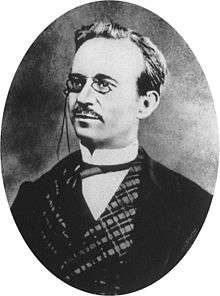 |
Urbano Rattazzi (1808–1873) |
3 March 1862 | 8 December 1862 | Historical Left | Rattazzi I | |||
| First leftist to become Prime Minister of Italy. He became president of the lower chamber in the first Italian Parliament. After Ricasoli's resignation formed a government with the support of The Right. Due to his policy of repression towards Garibaldi at Aspromonte, he was driven from office, after a popular reaction. | ||||||||
 |
Luigi Carlo Farini (1812–1866) |
8 December 1862 | 24 March 1863 | Historical Right | Farini | |||
| Previously a Sardinian minister under Cavour. Farini took office after the resignation of Rattazzi. During his cabinet, Farini carried out Cavour's national reorganisation policy. Resigned due to ill health. | ||||||||
 |
Marco Minghetti (1818–1886) |
24 March 1863 | 28 September 1864 | Historical Right | Minghetti I | |||
| Minister of the Interior under Cavour in the first Italian government. Minghetti concluded the September Convention with France, under which Napoleon III removed all French troops from Rome, and the Italian government was transferred from Turin to Florence. This led to violent protest in Turin, causing Minghetti to resign. | ||||||||
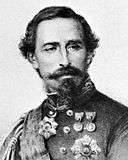 |
General Alfonso Ferrero la Marmora (1804–1878) |
28 September 1864 | 31 December 1865 | Historical Right | La Marmora I | |||
| 31 December 1865 | 20 June 1866 | La Marmora II | IX (1865) | |||||
| He took part in the war of 1859 against the Empire of Austria. In April 1866 La Marmora concluded an alliance with Prussia against Austria-Hungary and, on the outbreak of the Third Italian War of Independence in June, took command of an army corps. | ||||||||
 |
Bettino Ricasoli (1809–1880) |
20 June 1866 | 10 April 1867 | Historical Right | Ricasoli II | |||
| Upon the departure of the French troops from Rome at the end of 1866, he again attempted to conciliate the Vatican with a convention. The Vatican accepted his proposal, but the Italian Chamber of Deputies proved refractory, and, though dissolved by Ricasoli, returned more hostile than before. Ricasoli resigned office and thenceforward practically disappeared from political life. | ||||||||
 |
Urbano Rattazzi (1808–1873) |
10 April 1867 | 27 October 1867 | Historical Left | Rattazzi II | X (1867) | ||
| He served from April to October, replacing Ricasoli. Popular reaction to his hostility toward Garibaldi again drove him from office. | ||||||||
 |
Luigi Federico, conte Menabrea (1809–1896) |
27 October 1867 | 5 January 1868 | Historical Right | Menabrea I | |||
| 5 January 1868 | 13 May 1869 | Menabrea II | ||||||
| 13 May 1869 | 14 December 1869 | Menabrea III | ||||||
| Menabrea disavowed Garibaldi and instituted judicial proceedings against him. After multiple cabinet changes, and many crises, Menabrea resigned in December 1869 on the election of a new chamber in which he did not command a majority. | ||||||||
 |
Giovanni Lanza (1810–1882) |
14 December 1869 | 10 July 1873 | Historical Right | Lanza | XI (1870) | ||
| A resolute opponent of Menabrea economic policies, with his finance minister Quintino Sella, Lanza reorganized the Italian budget. His cabinet saw the accomplishment of Italian unity and the installation of an Italian government in Rome after the defeat of the Papal States in 1870. | ||||||||
 |
Marco Minghetti (1818–1886) |
10 July 1873 | 25 March 1876 | Historical Right | Minghetti II | XII (1874) | ||
| During his premiership, he inaugurated the rapprochement between Italy, Austria and Germany and reformed the naval and military administration; before his ouster he was able, as finance minister, to balance the State budget for the first time since 1860. | ||||||||
 |
Agostino Depretis (1813–1887) |
25 March 1876 | 25 December 1877 | Historical Left | Depretis I | XIII (1876) | ||
| 26 December 1877 | 24 March 1878 | Depretis II | ||||||
| Upon the death of Rattazzi in 1873, Depretis became leader of the Left. During his cabinet, he ousted Giuseppe Zanardelli and Alfredo Baccarini in order to please the Right, and subsequently assigned portfolios to Cesare Ricotti-Magnani, Robilant and other Conservatives, so as to complete the political process known as Trasformismo. | ||||||||
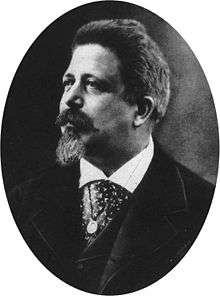 |
Benedetto Cairoli (1825–1889) |
24 March 1878 | 19 December 1878 | Historical Left | Cairoli I | Umberto I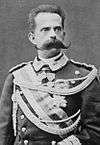 (1878–1900) | ||
| He permitted the Irredentist agitation to almost lead Italy to war with Austria. A few months later, the attempt of Giovanni Passannante to assassinate King Humbert at Naples (12 December 1878) caused his downfall, in spite of the courage displayed and the severe wound received by him in protecting the king's person on that occasion. | ||||||||
 |
Agostino Depretis (1813–1887) |
19 December 1878 | 14 July 1879 | Historical Left | Depretis III | |||
| He defeated his left-wing rival Benedetto Cairoli in December, becoming Prime Minister, but after a few months he was again replaced by Cairoli, who formed a new government with his support. As premier, he continued his policy of Trasformismo. | ||||||||
 |
Benedetto Cairoli (1825–1889) |
14 July 1879 | 25 November 1879 | Historical Left | Cairoli II | |||
| 25 November 1879 | 29 May 1881 | Cairoli III | XIV (1880) | |||||
| On 3 July 1879 Cairoli returned to power. Confidence in French assurances, and belief that Britain would never permit the extension of French influence in North Africa, prevented him from foreseeing the French occupation of Tunis (11 May 1881). Amid popular indignation, he resigned in order to avoid making inopportune declarations to the chamber. | ||||||||
 |
Agostino Depretis (1813–1887) |
29 May 1881 | 25 May 1883 | Historical Left | Depretis IV | |||
| 25 May 1883 | 30 March 1884 | Depretis V | XV (1882) | |||||
| 30 March 1884 | 29 June 1885 | Depretis VI | ||||||
| 29 June 1885 | 30 May 1886 | Depretis VII | ||||||
| 30 May 1886 | 4 April 1887 | Depretis VIII | XVI (1886) | |||||
| 4 April 1887 | 29 July 1887† | Depretis IX | ||||||
| During his long term of office, he abolished the grist tax, extended suffrage, completed the railway system, aided Mancini in forming the Triple Alliance and furthered colonialism by the occupation of Massawa; but he also vastly increased indirect taxation, corrupted and destroyed the fibre of parliamentary parties and impaired the stability of Italian finance.
†Died in office on 29 July 1887. | ||||||||
 |
Francesco Crispi (1819–1901) |
29 July 1887 | 9 March 1889 | Historical Left | Crispi I | |||
| 9 March 1889 | 6 February 1891 | Crispi II | XVII (1890) | |||||
| Crispi was the first Prime Minister from Southern Italy. He abolished the death penalty, removed anti-strike laws, limited police powers, reformed the penal code and the administration of justice with the help of his Minister of Justice Giuseppe Zanardelli, reorganised charities and passed public health laws and legislation to protect emigrants working abroad. His desire to make Italy a colonial power led to conflicts with France, which rejected Italian claims to Tunisia and opposed Italian expansion elsewhere in Africa. | ||||||||
 |
Antonio Starabba, Marchese di Rudinì (1839–1908) |
6 February 1891 | 15 May 1892 | Historical Right | Rudinì I | |||
| He succeeded to Crispi as Prime Minister, forming a coalition cabinet with Giovanni Nicotera's fragment of the left. His administration vacillated, but it initiated the economic reforms which effected a sound basis of Italian finances and also renewed the Triple Alliance. He was overthrown in May 1892, after a confidence vote in the Chamber of Deputies. | ||||||||
 |
Giovanni Giolitti (1842–1928) |
15 May 1892 | 15 December 1893 | Historical Left | Giolitti I | XVIII (1892) | ||
| Giolitti's first term as Prime Minister was marked by misfortune and misgovernment. Giolitti's political position, and the ensuing Banca Romana scandal obliged him to resign. His fall left the finances of the state disorganised, the pensions fund depleted, diplomatic relations with France strained due to the massacre of Italian workmen at Aigues-Mortes. He was forced to resign in 1893. | ||||||||
 |
Francesco Crispi (1819–1901) |
15 December 1893 | 10 March 1896 | Historical Left | Crispi III | |||
| In December 1893, 92 peasants lost their lives in clashes with the police and army. Government buildings were burned as well as flour mills and bakeries that refused to lower their prices when taxes were lowered or abolished. Crispi’s uncompromising suppression of disorder, and his refusal to abandon either the Triple Alliance or the Eritrean colony and the humiliating defeat of the Italian army at Adwa in March 1896 in Ethiopia during the First Italo-Ethiopian War, brought about his resignation after rioting in several Italian towns. | XIX (1895) | |||||||
 |
Antonio Starabba, Marchese di Rudinì (1839–1908) |
10 March 1896 | 11 July 1896 | Historical Right | Rudinì II | |||
| 11 July 1896 | 14 December 1897 | Rudinì III | ||||||
| 14 December 1897 | 1 June 1898 | Rudinì IV | XX (1897) | |||||
| 1 June 1898 | 29 June 1898 | Rudinì V | ||||||
| He signed the Treaty of Addis Ababa that formally ended the First Italo–Ethiopian War and recognised Ethiopian sovereignty. To satisfy the anti-colonial party, he ceded Kassala to Great Britain. Indignation at the results of his policy left him without support of both the Left and the Right, which blamed him for the permissiveness that allegedly had promoted the uprisings and led to his ouster in June 1898. | ||||||||
 |
General Luigi Pelloux (1839–1924) |
29 June 1898 | 14 May 1899 | Military | Pelloux I | |||
| 14 May 1899 | 24 June 1900 | Pelloux II | ||||||
| Pelloux took stern measures against the revolutionary elements in southern Italy. He adopted the Rudinì cabinet's Public Safety Bill for the reform of the police laws; it was eventually promulgated by royal decree. The new coercive law was fiercely obstructed by the Socialist Party of Italy (PSI), which, with the Left and Extreme Left, forced General Pelloux to dissolve the Chamber in May 1900, and to resign office after the general election in June. | ||||||||
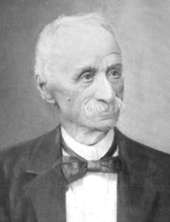 |
Giuseppe Saracco (1821–1907) |
24 June 1900 | 15 February 1901 | Historical Left | Saracco | XXI (1900) | ||
| In June 1900 he formed a Cabinet of pacification after the Obstructionist crisis had caused the downfall of General Pelloux. His term was clouded by the assassination of King Umberto (29 July 1900), and his administration was ended in February 1901 by a vote of the Chamber condemning his weak attitude towards a general dock strike at Genoa. | ||||||||
 |
Giuseppe Zanardelli (1826–1903) |
15 February 1901 | 3 November 1903 | Historical Left | Zanardelli | Victor Emmanuel III (1900–1946) | ||
| Zanardelli achieved little during his last term, due to poor health. His Divorce Bill, although voted in the Chamber of Deputies, was withdrawn because of popular opposition. He retired from the administration on 21 November 1903. | ||||||||
 |
Giovanni Giolitti (1842–1928) |
3 November 1903 | 12 March 1905 | Historical Left | Giolitti II | |||
| Giolitti courted the left and labour unions with social legislation. He repressed serious disorders throughout Italy and thus lost Socialist support. In March 1905 he resigned, indicating Alessandro Fortis as his successor. | XXII (1904) | |||||||
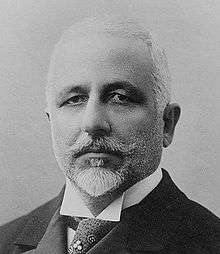 |
Tommaso Tittoni (1855–1931) |
12 March 1905 | 28 March 1905 | Historical Right | Tittoni | |||
| After the resignation of Giolitti in March 1905, Tittoni became interim Prime Minister for a few days and remained in Alessandro Fortis's cabinet as Foreign Minister. | ||||||||
 |
Alessandro Fortis (1842–1909) |
28 March 1905 | 24 December 1905 | Historical Left | Fortis I | |||
| 24 December 1905 | 8 February 1906 | Fortis II | ||||||
| With Giolitti, Fortis formed his government. During his administration, Fortis nationalized the railways, this was criticized by conservatives and radicals, so after less than a year he was forced to resign. | ||||||||
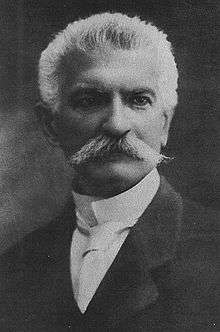 |
Sidney Sonnino (1847–1922) |
8 February 1906 | 29 May 1906 | Historical Right | Sonnino I | |||
| Sonnino formed a cabinet in opposition to Giolitti's Left, in coalition with the Radicals and with the external support of the Socialists. During his short cabinet, Sonnino formed an alliance with France on colonial expansion in North Africa. His government lasted only few months. | ||||||||
 |
Giovanni Giolitti (1842–1928) |
29 May 1906 | 11 December 1909 | Historical Left | Giolitti III | |||
| Golitti III Cabinet was named "The long ministry". With the support of PSI, he enacted laws reducing working hours for women and children. He also faced the Messina earthquake in 1908, which killed 130 thousand people. | ||||||||
 |
Sidney Sonnino (1847–1922) |
11 December 1909 | 31 March 1910 | Historical Right | Sonnino II | XXIII (1909) | ||
| Sonnino formed a government composed of conservative ministers and was supported by Giolitti. After a vote of confidence on transports Sonnino resigned. | ||||||||
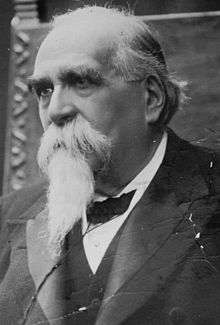 |
Luigi Luzzatti (1841–1927) |
31 March 1910 | 30 March 1911 | Historical Right | Luzzatti | |||
| His administration, which lasted until 18 March 1911, was unsuccessful. Luzzatti showed lack of energy in dealing with opposition and tried to avoid all measures likely to make him unpopular. | ||||||||
 |
Giovanni Giolitti (1842–1928) |
30 March 1911 | 21 March 1914 | Liberal Union | Giolitti IV | |||
| XXIV (1913) | ||||||||
| His government fought the Italo-Turkish War which made Libya an Italian colony. In 1912, Giolitti had the parliament approve an electoral reform bill that expanded the electorate from 3 million to 8.5 million voters, introducing near universal male suffrage. He resigned in March 1914. | ||||||||
 |
Antonio Salandra (1853–1931) |
21 March 1914 | 5 November 1914 | Liberal Union | Salandra I | |||
| 5 November 1914 | 18 June 1916 | Salandra II | ||||||
| As Giolitti's choice, Salandra came in power in March 1914. However, he soon fell out with Giolitti over the question of Italian participation in World War I. While Giolitti supported neutrality, Salandra supported intervention on the side of the Allies. He resigned following the Austrian offensive in Trentino. | ||||||||
 |
Paolo Boselli (1838–1932) |
18 June 1916 | 29 October 1917 | Liberal Union | Boselli | |||
| Boselli was appointed Prime Minister, following the collapse of the Salandra government as a result of military losses to Austria. His government fell in October 1917 as a result of the Italian military defeat in the Battle of Caporetto. | ||||||||
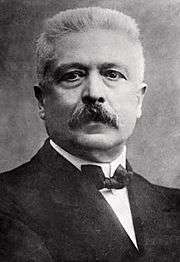 |
Vittorio Emanuele Orlando (1860–1952) |
23 October 1917 | 23 June 1919 | Liberal Union | Orlando | |||
| Orlando became Prime Minister after the military disaster in Caporetto. The Italians later won the Battle of Vittorio Veneto in November 1918, a feat that coincided with the collapse of Austro-Hungarian Army and the end of the First World War on the Italian Front. The fact that Italy recovered and ended up on the winning side in 1918 earned Orlando the title "Premier of Victory." He was the head of the Italian delegation at the Paris Peace Conference in 1919. His political position was seriously undermined by his failure to secure Italian interests at the Peace Conference. Orlando resigned on 23 June 1919. | ||||||||
 |
Francesco Saverio Nitti (1868–1953) |
23 June 1919 | 21 May 1920 | Radical Party | Nitti I | XXV (1919) | ||
| 21 May 1920 | 15 June 1920 | Nitti II | ||||||
| Nitti was the first radical Prime Minister of Italy. He had great difficulty keeping the administration functioning at all, due to enmity between the communists, anarchists and fascists. After less than a year as head of government, he resigned. | ||||||||
 |
Giovanni Giolitti (1842–1928) |
15 June 1920 | 4 July 1921 | Liberal Union | Giolitti V | |||
| He became Prime Minister during the "Red Biennium", when workers’ occupation of factories increased the fear of a communist takeover that led the political establishment to tolerate the rise of the fascists of Benito Mussolini. Giolitti enjoyed the support of the fascist squadristi and did not try to stop their forceful takeovers of city governments or their violence against their political opponents. | ||||||||
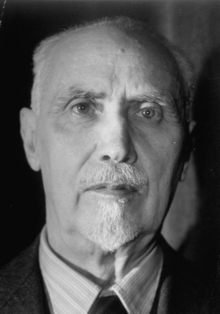 |
Ivanoe Bonomi (1873–1951) |
4 July 1921 | 26 February 1922 | Italian Reformist Socialist Party | Bonomi I | XXVI (1921) | ||
| He became Prime Minister of Italy for the first time, in a coalition government. He did not oppose fascist squadrist. Early in 1922, his government collapsed, and he was replaced as Prime Minister by Luigi Facta. | ||||||||
 |
Luigi Facta (1861–1930) |
26 February 1922 | 1 August 1922 | Liberal Union | Facta I | |||
| 1 August 1922 | 31 October 1922 | Facta II | ||||||
| Facta was appointed Prime Minister in February 1922, while Italy was in political turmoil, and was dealing with Mussolini's fascist insurgency. Facta did not openly oppose Mussolini and was slow to react to insurrectionist attitudes within the population. He resigned after the March on Rome. | ||||||||
 |
Benito Mussolini (1883–1945) (Head of the Government and Duce of Fascism from 1925) |
31 October 1922 | 25 July 1943 | National Fascist Party | Mussolini | |||
| XXVII (1924) | ||||||||
| XXVIII (1929) | ||||||||
| XXIX (1934) | ||||||||
| XXX ( •••• ) | ||||||||
| Mussolini is the longest-serving Prime Minister of Italy. He took the power with the March on Rome in October 1922. The first years of Mussolini's government were characterized by violence, repression and murders. In 1924 he nominated himself Duce. Press, radio, education and films were supervised to create the impression that fascism was the doctrine of the twentieth century, replacing liberalism and democracy. A lavish cult of personality centered on Mussolini was promoted by the regime. In 1929, Mussolini signed the Lateran Treaty with the Holy See. In 1936 Mussolini founded the Italian Empire after the winning of the Second Italo-Ethiopian War. In 1939 he signed the Pact of Steel with Nazi Germany of Adolf Hitler. With Mussolini, Italy entered in the World War II in 1940 with the Axis Powers; but after three years the Allies invaded Sicily, Mussolini was deposed and imprisoned by the King on Gran Sasso in Abruzzo. Rescued by the Germans, Mussolini reorganised his forces in the north of Italy, at the head of a puppet-state, called Italian Social Republic. | ||||||||
 |
Marshal Pietro Badoglio (1871–1956) |
25 July 1943 | 17 April 1944 | Military | Badoglio I | Constitutional Transition | ||
| 22 April 1944 | 18 June 1944 | Badoglio II | ||||||
| Badoglio was appointed after the arrest of Mussolini. On 8 September the armistice document was published by the Allies in the Badoglio Proclamation. In the early hours of 9 September, Badoglio, King Victor Emmanuel III, some military ministries, and the Chief of the General Staff escaped to Pescara and Brindisi seeking Allied protection. Following the German rescue of Mussolini, the liberation of Rome, and increasingly strong opposition, he was replaced on 9 June 1944 by Ivanoe Bonomi. | ||||||||
 |
Ivanoe Bonomi (1873–1951) |
18 June 1944 | 10 December 1944 | Labour Democratic Party | Bonomi II | Umberto II Luogotenente (1944–1946) King (1946) | ||
| 12 December 1944 | 19 June 1945 | Bonomi III | ||||||
| He led Italy during the retreat of the Fascist Italian Social Republic and the German military, and helped the country's transition to democracy. He remained Prime Minister until 1945, by which time World War in Europe had ended. | ||||||||
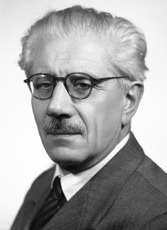 |
Ferruccio Parri (1890–1981) |
21 June 1945 | 8 December 1945 | Action Party | Parri | |||
| He led a government supported by the Action Party, Christian Democracy, the Communist Party, the Socialist Party, the Liberal Party and others. When the Liberals withdrew their support from the coalition government, Parri resigned. | ||||||||
 |
Alcide De Gasperi (1881–1954) |
10 December 1945 | 10 July 1946 | Christian Democracy | De Gasperi I | |||
| Last Prime Minister of the Kingdom of Italy. Lead a coalition government with the PCI and the PSI. Communist party leader Palmiro Togliatti acted as vice-premier. He tried soften the terms of the pending Allied peace treaty with Italy and secured financial and economic aid through the European Recovery Program (Marshal Plan), which was opposed by the Communists. | ||||||||
Presidents of the Council of Ministers of the Italian Republic (1946–present)
- Parties
- 1946–1993: (Multiparty system)
Christian Democracy Republican Party Socialist Party Independent
- Since 1994: (Two-coalitions system)
Centre-right (FI/PdL) Centre-left (Ulivo/PD)
- Coalitions
Centrist coalition Centre-right coalition Centre-left coalition Mixed coalition
| Portrait | Name (Birth–Death) |
Term of office | Political Party | Government | Composition | Legislature | President | |||
|---|---|---|---|---|---|---|---|---|---|---|
 |
Alcide De Gasperi (1881–1954) |
10 July 1946 | 2 February 1947 | Christian Democracy | De Gasperi II | DC-PSI-PCI-PRI | Const. (1946) |
Enrico De Nicola  (1946–1948) | ||
| 2 February 1947 | 31 May 1947 | De Gasperi III | DC-PSI-PCI | |||||||
| 31 May 1947 | 23 May 1948 | De Gasperi IV | Centrism DC-PSDI-PLI-PRI | |||||||
| 23 May 1948 | 27 January 1950 | De Gasperi V | I (1948) | Luigi Einaudi (1948–1955) | ||||||
| 27 January 1950 | 26 July 1951 | De Gasperi VI | Centrism DC-PSDI-PRI | |||||||
| 26 July 1951 | 16 July 1953 | De Gasperi VII | DC-PRI | |||||||
| 16 July 1953 | 17 August 1953 | De Gasperi VIII | DC | II (1953) | ||||||
| De Gasperi's eight-year rule remains the longest in modern Italian politics. During his successive governments, Italy became a Republic (1946), signed a Peace Treaty with the Allies (1947), and joined NATO in 1949 and became an ally of the United States, which helped to revive the Italian economy through the Marshall Plan. Italy also became a member of the European Coal and Steel Community (ECSC), predecessor of the European Union (EU). He signed the Gruber-De Gasperi Agreement with Austria in September 1946 establishing his home region, southern Tyrol, as an autonomous region. When the Christian Democrats did not gain a majority in the 1953 general election, De Gasperi was unable to establish a workable government and was forced to resign as Prime Minister. | ||||||||||
 |
Giuseppe Pella (1902–1981) |
17 August 1953 | 12 January 1954 | Christian Democracy | Pella | DC and Independents | ||||
| After the political crisis caused by the failure of the Cheat Law, Pella was appointed Prime Minister. Pella gained further critics when, by issuing nationalistic declarations, he created strife with Josip Broz Tito regarding the Free Territory of Trieste. Pella resigned on 12 January 1954. | ||||||||||
 |
Amintore Fanfani (1908–1999) |
18 January 1954 | 8 February 1954 | Christian Democracy | Fanfani I | DC | ||||
| The Fanfani I cabinet lasted only 21 days when it failed to win approval in the Parliament. He tried to form a centre-left government but was opposed by conservatives. It is one of the shortest governments in the history of Italian politics. | ||||||||||
 |
Mario Scelba (1901–1991) |
10 February 1954 | 6 July 1955 | Christian Democracy | Scelba | DC-PSDI-PLI | ||||
| Scelba helped resolve outstanding wartime issues like the recovery of Trieste for Italy and pushed through the Paris Peace Treaties of 1947 with the wartime Allied powers. His fall was accomplished by his own party, due to political manoeuvring of party rivals like former Premier Giuseppe Pella and party Secretary Amintore Fanfani. | ||||||||||
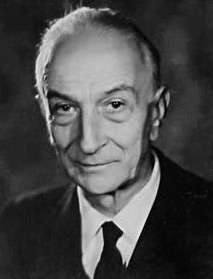 |
Antonio Segni (1891–1972) |
6 July 1955 | 15 May 1957 | Christian Democracy | Segni I | DC-PSDI-PLI | Giovanni Gronchi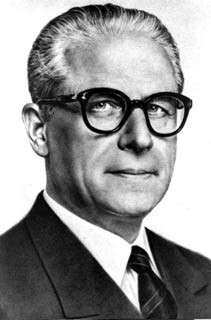 (1955–1962) | |||
| During Segni’s government, the treaties instituting the European Economic Community (EEC) were signed on 25 March 1957, and Italy co-founded the community. His conservative cabinet was opposed by Fanfani's left-leaning DC current. | ||||||||||
 |
Adone Zoli (1887–1960) |
19 May 1957 | 1 July 1958 | Christian Democracy | Zoli | DC | ||||
| Zoli resigned the post of Prime Minister due to his need for the votes of the neo-fascist Italian Social Movement to form a majority in the Parliament. He was then convinced by President of the Republic, Giovanni Gronchi, to remain in the post until the natural dissolution of the Italian Parliament in 1958. Zoli was the sole Italian Senator in office to become Prime Minister. | ||||||||||
 |
Amintore Fanfani (1908–1999) |
1 July 1958 | 15 February 1959 | Christian Democracy | Fanfani II | DC-PSDI | III (1958) | |||
| Fanfani tried to create a centre-left government, searching for a cooperation with the Italian Socialist Party. He lost the support of his own Christian Democratic colleagues, who were against the agreement. He resigned on 26 January 1959. | ||||||||||
 |
Antonio Segni (1891–1972) |
15 February 1959 | 23 March 1960 | Christian Democracy | Segni II | DC | ||||
| Segni was a conservative opposed to Fanfani's consociational strategy. His cabinet was supported externally by Liberals, Monarchists and the Italian Social Movement. He resigned after just over a year. | ||||||||||
 |
Fernando Tambroni (1882–1963) |
25 March 1960 | 26 July 1960 | Christian Democracy | Tambroni | DC | ||||
| Tambroni was elected with supper of the Italian Social Movement, among others. On 21 May 1960, a street assembly led by the Communist leader was stopped by police, with the support of the government. This caused a series of riots. On 30 June 1960, a large demonstration summoned by the left-wing CGIL trade union in the streets of Genoa was heavily suppressed by the Italian police. Then Tambroni was forced to resign. | ||||||||||
 |
Amintore Fanfani (1908–1999) |
26 July 1960 | 21 February 1962 | Christian Democracy | Fanfani III | DC | ||||
| 21 February 1962 | 21 June 1963 | Fanfani IV | DC-PSDI-PRI | Antonio Segni (1962–1964) | ||||||
| Fanfani became Prime Minister again and secured the support of the Italian Socialist Party, thus involving the centre-left in Italian politics. In February 1962 he reorganised his cabinet and gained the benign abstention of the PSI leader Pietro Nenni, but they were not part of the government. Resigned in 1963. | ||||||||||
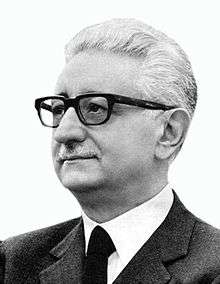 |
Giovanni Leone (1908–2001) |
21 June 1963 | 4 December 1963 | Christian Democracy | Leone I | DC | IV (1963) | |||
| A member of the right-wing faction of Christian Democracy, Leone formed a transition government. His cabinet approved the budget law. Resigned after few months in December 1963. | ||||||||||
 |
Aldo Moro (1916–1978) |
4 December 1963 | 22 July 1964 | Christian Democracy | Moro I | Organic Centre-left (DC-PSI-PSDI-PRI) | ||||
| 22 July 1964 | 23 February 1966 | Moro II | Giuseppe Saragat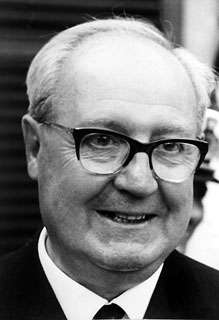 (1964–1971) | |||||||
| 23 February 1966 | 24 June 1968 | Moro III | ||||||||
| In 1963 Moro was nominated Prime Minister of Italy for the first time. His government was unevenly supported by Christian Democracy, but also by the Italian Socialist Party. The centre-left coalition, a first for the Italian post-war political panorama, stayed in power until the 1968 general elections. Moro's 3rd cabinet stayed in power for 833 days, a record for Italy's so-called "First Republic". Many social reforms were carried out during Moro's tenures. | ||||||||||
 |
Giovanni Leone (1908–2001) |
24 June 1968 | 12 December 1968 | Christian Democracy | Leone II | DC | V (1968) | |||
| The former conservative premier Leone formed a transition government to approve the budget law. He remained in power for a few months after the 1968 general election. | ||||||||||
 |
Mariano Rumor (1915–1990) |
12 December 1968 | 5 August 1969 | Christian Democracy | Rumor I | Organic Centre-left (DC-PSI-PSDI-PRI) | ||||
| 5 August 1969 | 27 March 1970 | Rumor II | DC | |||||||
| 27 March 1970 | 6 August 1970 | Rumor III | Organic Centre-left (DC-PSI-PSDI-PRI) | |||||||
| Rumor was a member of the left-wing faction of Christian Democracy. During his cabinets, the Worker's Status and the creation of new Regions were approved. Rumor faced the Piazza Fontana bombing and the violence of the beginning of the Years of Lead. | ||||||||||
 |
Emilio Colombo (1920–2013) |
6 August 1970 | 17 February 1972 | Christian Democracy | Colombo | Organic Centre-left (DC-PSI-PSDI-PRI) | ||||
| During his term, Colombo on several occasions held portfolios such as Treasury, Finance, Budget and Foreign. Like Rumor, Colombo did not resolve the riots, bombings and other current social issues. | ||||||||||
 |
Giulio Andreotti (1919–2013) |
17 February 1972 | 26 June 1972 | Christian Democracy | Andreotti I | DC | Giovanni Leone (1971–1978) | |||
| 26 June 1972 | 7 July 1973 | Andreotti II | DC-PSDI-PLI | VI (1972) | ||||||
| Andreotti was a member of the right-wing faction of Christian Democracy. In his two consecutive centre-right cabinets, Andreotti strengthened Italy's alliance with NATO. He did not solve the social tensions of the Years of Lead. | ||||||||||
 |
Mariano Rumor (1915–1990) |
26 July 1973 | 14 March 1974 | Christian Democracy | Rumor IV | Organic Centre-left (DC-PSI-PSDI-PRI) | ||||
| 14 March 1974 | 23 November 1974 | Rumor V | DC-PSI-PSDI | |||||||
| Rumor was re-elected Prime Minister in 1973, but after a year of students' and workers' protests and the riot due to the 1974 divorce referendum, Rumor was forced to resign. | ||||||||||
 |
Aldo Moro (1916–1978) |
23 November 1974 | 12 February 1976 | Christian Democracy | Moro IV | DC-PRI | ||||
| 12 February 1976 | 29 July 1976 | Moro V | Compromesso (DC with PCI's support) | |||||||
| The former Prime Minister Moro returned to power in 1974. As premier he concluded the Osimo Treaty with Yugoslavia, defining the official partition of the Free Territory of Trieste. Moro continued his social reforms. | ||||||||||
 |
Giulio Andreotti (1919–2013) |
29 July 1976 | 11 March 1978 | Christian Democracy | Andreotti III | Compromesso (DC with PCI's support) |
VII (1976) | |||
| 11 March 1978 | 20 March 1979 | Andreotti IV | ||||||||
| 20 March 1979 | 4 August 1979 | Andreotti V | DC-PSDI-PRI | Sandro Pertini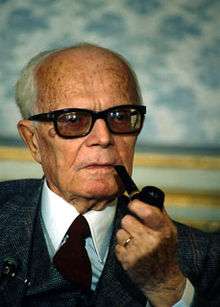 (1978–1985) | ||||||
| After the 1976 general election, Moro and Fanfani proposed the "historic compromise", a governing coalition of Christian Democracy and the Italian Communist Party for the first time. Andreotti led the first experiment in that direction. The relationship was based on non-sfiducia ("non-challenge", or abstaining in any confidence vote). Another cabinet was formed on 16 March 1978, the day on which Aldo Moro was kidnapped by the revolutionary communist terrorist group the Red Brigades. The situation which followed brought the PCI to vote for Andreotti's cabinet for the sake of what was called "national solidarity". Andreotti's role during the kidnapping of Moro is controversial. Moro was killed in May 1978. Laws approved during his tenure include the reform of the National Health Service. | ||||||||||
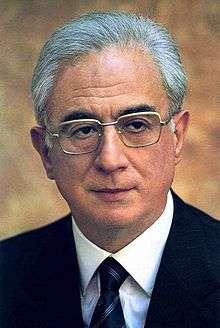 |
Francesco Cossiga (1928–2010) |
4 August 1979 | 4 April 1980 | Christian Democracy | Cossiga I | DC-PSDI-PLI | VIII (1979) | |||
| 4 April 1980 | 18 October 1980 | Cossiga II | DC-PSI-PRI | |||||||
| Cossiga was a member of the right-wing faction of Christian Democracy. During his ministry, Cossiga signed pacts with the German Chancellor Helmut Schmidt. He resigned less than two years after his first appointment. | ||||||||||
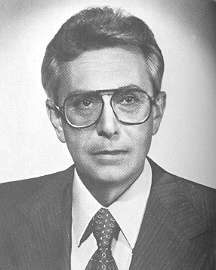 |
Arnaldo Forlani (1925–) |
18 October 1980 | 28 June 1981 | Christian Democracy | Forlani | DC-PSI-PSDI-PRI | ||||
| Forlani handled corruption scandals within his party, the 1980 Irpinia earthquake and a renewed bout of leftist violence. He was known as a mild-mannered politician who attempted to avoid his party's factionalism. During his presidency, the list of the secret lodge P2's membership was published. Forlani was criticised for the list's delayed publication. He was therefore compelled to resign. With his resignation, the unbroken line of Christian Democrat Prime Ministers since 1945 came to an end. | ||||||||||
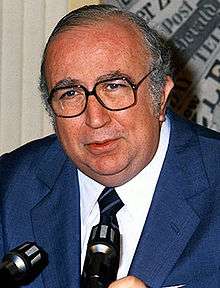 |
Giovanni Spadolini (1925–1994) |
28 June 1981 | 23 August 1982 | Italian Republican Party | Spadolini I | Pentapartito (DC-PSI-PSDI-PRI-PLI) | ||||
| 23 August 1982 | 1 December 1982 | Spadolini II | ||||||||
| Spadolini was the first non-Christian Democrat post-war Prime Minister. In 1982 he was forced to resign because the leader of the Socialist Party, Bettino Craxi, withdrew his support for the government. | ||||||||||
 |
Amintore Fanfani (1908–1999) |
1 December 1982 | 4 August 1983 | Christian Democracy | Fanfani V | DC-PSI-PSDI-PLI | ||||
| From 1982 to 1983, Fanfani was Prime Minister for the fifth time. He continued his policy of rapport with the Socialists and the Communists. Fanfani was forced to resign after Christian Democracy's poor results in the 1983 general election. | ||||||||||
 |
Bettino Craxi (1934–2000) |
4 August 1983 | 1 August 1986 | Italian Socialist Party | Craxi I | Pentapartito (DC-PSI-PRI-PSDI-PLI) |
IX (1983) | |||
| 1 August 1986 | 17 April 1987 | Craxi II | Francesco Cossiga (1985–1992) | |||||||
| During Craxi's tenure as Prime Minister, Italy became the fifth-largest industrial nation and gained entry into the G7. Double-digit inflation was addressed by eliminating a wage-price increase link; under this system, wages were increased in tandem with inflation. Removal of the link reduced inflation, which was falling in other major countries as well, but inevitably increased strikes in the long term, as workers had to collectively bargain for better salaries. In any case, the victory of the "No" front in the referendum called by the Italian Communist Party was also a major victory for Craxi. Budget deficits caused the national debt to skyrocket to beyond 100% of the gross national product. After four years of government, Craxi resigned in 1987. | ||||||||||
 |
Amintore Fanfani (1908–1999) |
17 April 1987 | 28 July 1987 | Christian Democracy | Fanfani VI | DC and independents | ||||
| From April to July 1987, Fanfani was Prime Minister for the sixth time. He was elected to the prestigious post of chairman of the Foreign Affairs Committee of the Senate from 1994–1996. | ||||||||||
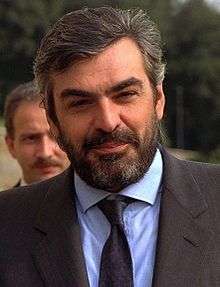 |
Giovanni Goria (1943–1994) |
28 July 1987 | 13 April 1988 | Christian Democracy | Goria | Pentapartito (DC-PSI-PRI-PSDI-PLI) |
X (1987) | |||
| After less than a year in power, Goria resigned in 1993 during a corruption scandal which ruined his party. Goria himself was charged with corruption. | ||||||||||
 |
Ciriaco De Mita (1928–) |
13 April 1988 | 22 July 1989 | Christian Democracy | De Mita | Pentapartito (DC-PSI-PRI-PSDI-PLI) | ||||
| De Mita served as Prime Minister for a year, maintaining the party chairmanship of Christian Democracy. At the beginning of that service, on 16 April 1988, in Forlì, Red Brigades killed Senator Roberto Ruffilli, an advisor to De Mita. | ||||||||||
 |
Giulio Andreotti (1919–2013) |
22 July 1989 | 12 April 1991 | Christian Democracy | Andreotti VI | Pentapartito (DC-PSI-PRI-PSDI-PLI) | ||||
| 12 April 1991 | 24 June 1992 | Andreotti VII | Quadripartito (DC-PSI-PSDI-PLI) | |||||||
| In 1992, at the end of the legislature, Andreotti resigned as Prime Minister. The previous year, Cossiga had appointed him senator for life. He was a candidate for President of Italy, but was defeated by Oscar Luigi Scalfaro. Due to the scandals uncovered during the Mani pulite judicial investigations, Andreotti resigned. He was the last Christian Democratic Prime Minister of Italy. | ||||||||||
| Giuliano Amato (1938–) |
28 June 1992 | 28 April 1993 | Italian Socialist Party | Amato I | Quadripartito (DC-PSI-PLI-PSDI) |
XI (1992) | Oscar Luigi Scalfaro (1992–1999) | |||
| During Amato's ten-month tenure, corruption scandals toppled much of the political establishment. Amato himself was never implicated, despite his ties to Bettino Craxi, a central figure in the corrupt political system. After two devaluations of the lira in the wake of currency speculation that led Italy to be expelled from the European Monetary System, Parliament cut the budget deficit drastically. This facilitated Italy's eventual adhesion to the Euro. | ||||||||||
 |
Carlo Azeglio Ciampi (1920–2016) |
28 April 1993 | 10 May 1994 | Independent | Ciampi | DC-PSI-PDS-PLI-PSDI-FdV | ||||
| Ciampi led a coalition government supported by most of the parties in the Parliament. His government continued reforms to adopt the Euro currency. Ciampi was the last Prime Minister of the First Republic. | ||||||||||
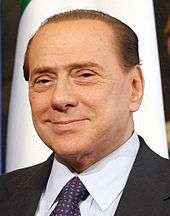 |
Silvio Berlusconi (1936–) |
10 May 1994 | 17 January 1995 | Forza Italia | Berlusconi I | PdL-PBG (FI-LN-AN-CCD-UdC) |
XII (1994) | |||
| Berlusconi was the first Prime Minister of the so-called "Second Republic". His three television networks promoted his Forza Italia party, which placed first in the 1994 general election. He was appointed Prime Minister in 1994 and resigned later that year when the Lega Nord exited his governing coalition. | ||||||||||
 |
Lamberto Dini (1931–) |
17 January 1995 | 17 May 1996 | Independent | Dini | Independents (supported by PDS, PSI, FdV, Network, CS, LN) | ||||
| In January 1995, Dini was appointed Prime Minister by President Oscar Luigi Scalfaro. Dini also took the portfolio for treasury in the cabinet and was a non-elected Prime Minister and minister. Though he was a supporter of monetarist policies, he was supported by left-wing and centrist parties as well as the Lega Nord. Dini's cabinet was considered a "technocratic" government. | ||||||||||
.jpg) |
Romano Prodi (1939–) |
17 May 1996 | 21 October 1998 | The Olive Tree | Prodi I | L'Ulivo (PDS-PPI-RI-FdV-UD) |
XIII (1996) | |||
| Prodi's government complied with European Monetary System parameters and effected Italy's adoption of the Euro currency. This was achieved in little more than six months. His government fell in 1998 when the Communist Refoundation Party withdrew its external support. Massimo D'Alema replaced Prodi as Prime Minister. Some claim that D'Alema engineered the collapse of the Prodi government to become Prime Minister himself. | ||||||||||
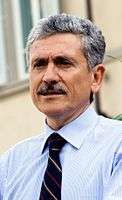 |
Massimo D'Alema (1949–) |
21 October 1998 | 22 December 1999 | The Olive Tree (Democrats of the Left) |
D'Alema I | L'Ulivo (DS-PPI-RI-SDI-FdV-PdCI-UDR) | ||||
| 22 December 1999 | 25 April 2000 | D'Alema II | Carlo Azeglio Ciampi (1999–2006) | |||||||
| In 1998, D'Alema became the first former Communist to become Prime Minister of a NATO country. He was supported by The Olive Tree coalition. Under D'Alema's leadership, Italy took part in the NATO bombing of the Federal Republic of Yugoslavia in 1999, to the consternation of some of his left-wing allies. When the Italian Communist Party (PCI) became the Democratic Party of the Left (PDS), D'Alema stressed that its Marxist roots should be replaced with social-democratic ideals. | ||||||||||
| Giuliano Amato (1938–) |
25 April 2000 | 11 June 2001 | The Olive Tree | Amato II | L'Ulivo (DS-PPI-Dem-FdV-PdCI-UDEUR-RI-SDI) | |||||
| Amato promoted economic competitiveness as well as social protection. In addition to economic reforms, he pushed ahead with political and institutional reforms, trying to deal with a weak executive and fragmented legislature. His government did not succeed in reducing the media power of Berlusconi, and for this he was criticised by the left. | ||||||||||
 |
Silvio Berlusconi (1936–) |
11 June 2001 | 23 April 2005 | Forza Italia | Berlusconi II | House of Freedoms (FI-AN-LN-UDC-NPSI-PRI) |
XIV (2001) | |||
| 23 April 2005 | 17 May 2006 | Berlusconi III | ||||||||
| Berlusconi's second cabinet became the longest serving in the history of the Italian Republic. Berlusconi's governments were characterised modest economic liberalisation and also by many attempts to reform the Italian Constitution and mild authoritarianism (Editto Bulgaro). Taxes were simplified and reforms to reduce crime were passed. In 2001, Berlusconi supported the War in Afghanistan and, in 2003, Italy participated in the Invasion of Iraq. On 13 February 2003 almost 2 million people protested in Rome against the war. The opposition criticised the Berlusconi government's relationships with Vladimir Putin's Russia and Muammar Gaddafi's Libya. After losses in the 23 April 2005 regional election, Berlusconi formed a new government with the same allies, reshuffling ministers and amending the government program. | ||||||||||
.jpg) |
Romano Prodi (1939–) |
17 May 2006 | 8 May 2008 | The Olive Tree | Prodi II | L'Unione (DS-DL-PRC-RnP-PdCI-IdV-FdV-UDEUR) |
XV (2006) | Giorgio Napolitano (2006–2015) | ||
| On 18 May 2006, Prodi pledged to withdraw Italian troops from Iraq and called the Iraq war a "grave mistake that has not solved but increased the problem of security". In his earlier months as Prime Minister, Prodi had a key role in the creation of a multinational peacekeeping force in Lebanon following the 2006 Israel-Lebanon conflict. Prodi's government faced a crisis over policies in early 2007. Three ministers in Prodi's Cabinet boycotted a vote in January to continue funding for Italian troop deployments in Afghanistan. Two years after his election, Prodi lost his majority in the Senate and was forced to resign. | ||||||||||
 |
Silvio Berlusconi (1936–) |
8 May 2008 | 16 November 2011 | The People of Freedom | Berlusconi IV | Centre-right Coalition (PdL-LN-MpA) |
XVI (2008) | |||
| Berlusconi's fourth cabinet was the second-longest serving of the Italian Republic. After the 2008 general election, Berlusconi gained a large parliamentary majority. Italy maintained the relationships with Russia, Libya and the United States. After the April 2009 earthquake in L'Aquila which caused the death of more than 300 people, the government provided emergency management and awarding of reconstruction contracts. In 2009 Berlusconi was hit in the face with an alabaster statuette of Milan Cathedral after a rally in Milan's Piazza del Duomo. Berlusconi was accused of restricting the freedom of information, including against Italian Wikipedia. In early 2010, Berlusconi's government launched the Riforma Gelmini education programme. In late 2010, the governing People of Freedom split, with some members leaving the party to create an opposition party called Future and Freedom. In 2011, after protests and riots, sexual scandals and the debt crisis, Berlusconi was forced to resign. | ||||||||||
| Mario Monti (1943–) |
16 November 2011 | 28 April 2013 | Independent | Monti | Independent (supported by PdL, PD, UdC, FLI) | |||||
| Monti led a technocratic government. On 4 December 2011, Monti's government increased taxes, reformed pensions and passed anti-tax evasion measures in response to economic weakness and to restore market confidence, after rising Italian government bond yields threatened Italy's financial stability. Monti's government tried to modify Article 18 of the Italian Work Law (Statuto dei Lavoratori), defining workers' rights, causing several protests. On the 8 December 2012, after losing his majority due to the People of Freedom's withdrawal, Monti announced his resignation. He officially resigned on 21 December after the approval of the Stability Pact by Parliament. Monti founded the Civic Choice party in January 2013, which lost badly in 2013 general election. Monti continued to be Prime Minister until 28 April 2013, when a new government was formed. | ||||||||||
 |
Enrico Letta (1966–) |
28 April 2013 | 22 February 2014 | Democratic Party | Letta | Grand coalition (PD-PdL/NCD-SC-PI-Independents) |
XVII (2013) | |||
| On 27 April 2013, Letta formally accepted the task of heading the Italian Republic's first grand coalition government, with support from his party, the People of Freedom and Monti's Civic Choice. In November 2013, Silvio Berlusconi announced the refoundation of Forza Italia, in opposition to the government. On 17 November 2013, more than sixty deputies of the People of Freedon founded the New Centre-Right in support of the Letta Cabinet. On 13 February 2014, following tensions with his Democratic rival Matteo Renzi, Letta announced he would resign as Prime Minister the following day. | ||||||||||
 |
Matteo Renzi (1975–) |
22 February 2014 | present | Democratic Party | Renzi | PD-AP-Independents | ||||
| At the age of 39, Matteo Renzi became the youngest Prime Minister in the history of Italy and his rise to become Prime Minister is considered a generational change. In April 2014, Renzi forced the chief executives of Italy's biggest state-owned companies, including Eni, Enel and Poste Italiane, to resign, and he subsequently appointed women to the majority of new positions, making it the first time any woman had served as a chief executive of a state-owned company. On 25 May 2014, in the European Parliament election, the Democratic Party gained 41% of the vote, the best result achieved by an Italian political party since 1958, and it became the most voted party in the European Union. On 3 December 2014 the Parliament approved the Jobs Act, which abolished the Article 18 of the Workers' Statute. On 4 May 2015, the Chamber approved the new electoral law and on 13 October 2015 the Senate and on 12 April 2016 the Chamber voted in favour of the constitutional reform to abolish the perfect bicameralism. The reforms for the transformation of the Senate into a federal upper chamber and a new electoral law has caused Renzi to be considered authoritarian and anti-democratic. During his premiership Renzi had to face a huge migrant crisis, with hundreds of thousands of refugees who arrived to Italy by boats. On 11 May 2016 the Chamber of Deputies approved the Cirinnà Law, that recognize civil unions for same-sex couples. | Sergio Mattarella (2015–) | |||||||||
Timeline
Kingdom of Italy (1861–1946)
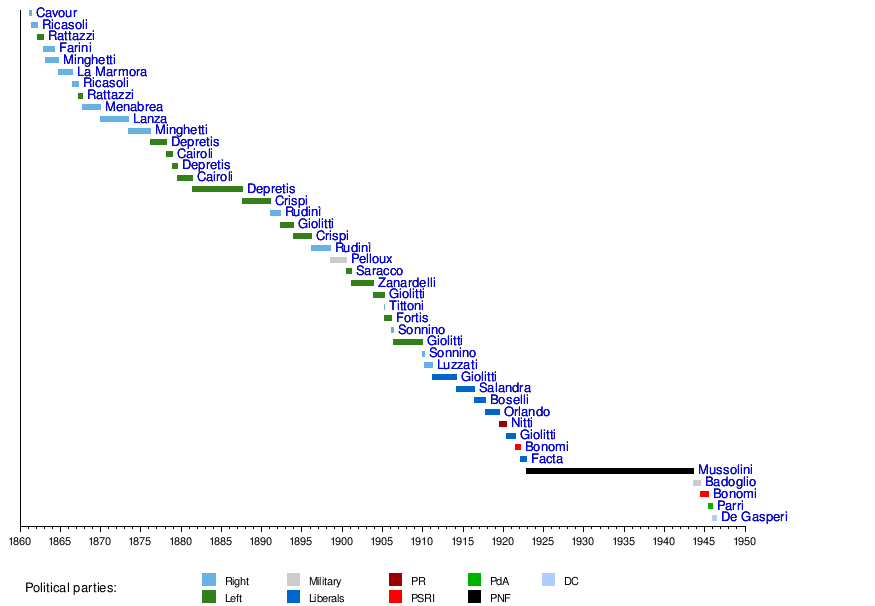
Italian Republic (1946–present)
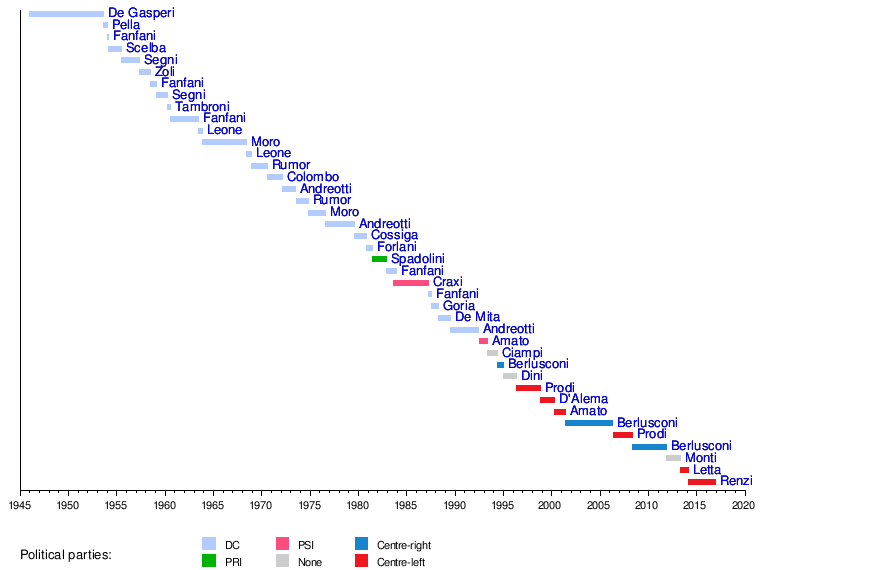
Living former Prime Ministers
There are nine living former Italian Prime Ministers:
- Living former Prime Ministers
-

Arnaldo Forlani
served 1980–81 -

Ciriaco De Mita
served 1988–89 -
Giuliano Amato
served 1992–93;
2000–01 -

Silvio Berlusconi
served 1994–95;
2001–06; 2008–11 -

Lamberto Dini
served 1995–96 -
.jpg)
Romano Prodi
served 1996–98; 2006–08 -

Massimo D'Alema
served 1998–2000 -
Mario Monti
served 2011–13 -

Enrico Letta
served 2013–14
See also
- Politics of Italy
- Prime Minister of Italy
- Lists of incumbents
- List of Prime Ministers of Italy by time in office
- Deputy Prime Minister of Italy